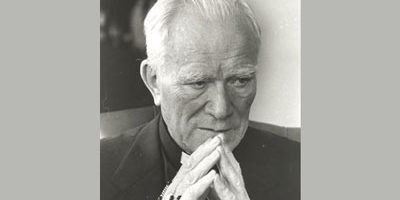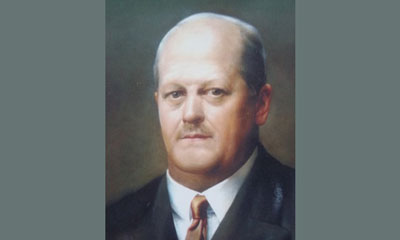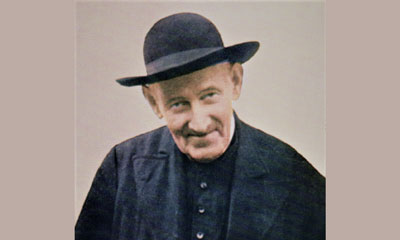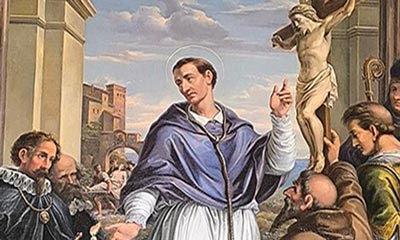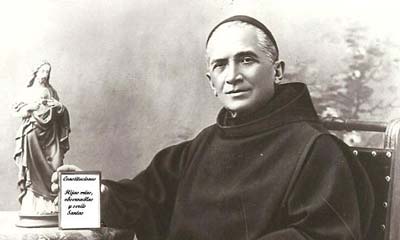August 20, 2020
Father Patrick Peyton
Dear Friends,
“The family that prays together stays together,” Father Patrick Peyton continually said. Pope St. John Paul II repeated this phrase in his encyclical on the Rosary: “As a prayer for peace, the Rosary is also, and always has been, a prayer of and for the family. At one time this prayer was particularly dear to Christian families, and it certainly brought them closer together. It is important not to lose this precious inheritance. We need to return to the practice of family prayer and prayer for families, continuing to use the Rosary… The family that prays together stays together. The Holy Rosary, by age-old tradition, has shown itself particularly effective as a prayer which brings the family together. Individual family members, in turning their eyes towards Jesus, also regain the ability to look one another in the eye, to communicate, to show solidarity, to forgive one another and to see their covenant of love renewed in the Spirit of God.” (Rosarium Virginis Mariae, February 2, 2002, No. 41). The twentieth century was blessed with a deeply influential apostle of the Rosary, Father Patrick Peyton, a priest of the Congregation of Holy Cross who made full use of modern technology.
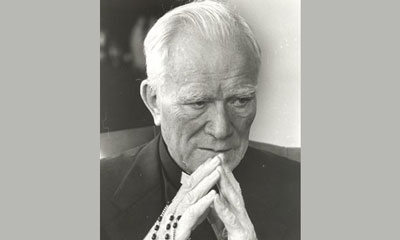 Patrick Peyton was born on January 9, 1909, the sixth of John and Mary Peyton’s nine children. The family lived in poverty on their small farm in Carracastle, County Mayo, Ireland. In the evenings, they gathered together to recite the rosary by the light of the fire. Every Sunday and feast day, the family walked to St. Joseph’s Parish Church in Attymass, where Patrick had been baptized four days after his birth. The father’s poor health did not enable him to provide for his family as he wanted; they often had to go to bed without supper. The eldest child emigrated to the United States to find work and help her family; soon two other sisters followed. In 1928, Patrick and his older brother Tom joined their sisters in Scranton, Pennsylvania. Tom found work in the coal mines, and Patrick became a sacristan at the cathedral.
Patrick Peyton was born on January 9, 1909, the sixth of John and Mary Peyton’s nine children. The family lived in poverty on their small farm in Carracastle, County Mayo, Ireland. In the evenings, they gathered together to recite the rosary by the light of the fire. Every Sunday and feast day, the family walked to St. Joseph’s Parish Church in Attymass, where Patrick had been baptized four days after his birth. The father’s poor health did not enable him to provide for his family as he wanted; they often had to go to bed without supper. The eldest child emigrated to the United States to find work and help her family; soon two other sisters followed. In 1928, Patrick and his older brother Tom joined their sisters in Scranton, Pennsylvania. Tom found work in the coal mines, and Patrick became a sacristan at the cathedral.
From an early age, Patrick felt called to the priesthood, but since he couldn’t afford the required studies, he somewhat bitterly gave up his dream. His job at the cathedral, close to the Blessed Sacrament, comforted him and gave him the chance to confide his desire to be a priest to the bishop; Tom would do the same a few weeks later. Touched, the prelate decided to pay for their education in a religious school. Both boys were older than their classmates, but their desire to become priests helped them endure the resultant humiliations. At the time, a mission was being preached by priests of the Congregation of Holy Cross (an institute founded in 1837 in Le Mans, France, by Blessed Basile Moreau to fund pastoral activity and education). Impressed, Patrick and Tom asked to be admitted to their Institute. They entered Holy Cross Seminary at Notre Dame University in Indiana and then entered the novitiate; on completion they took their first religious vows, and pursued Bachelor of Arts degrees in philosophy.
The treasurer of divine blessings
Patrick, who wanted to be a missionary, was sent to the Holy Cross Foreign Missions Seminary in Washington, DC. However, he returned to the Notre Dame community after contracting tuberculosis during his third year of theology. Despite a year in the infirmary, he did not recover and his health continued to deteriorate. An elderly priest then encouraged him to place all his trust in the powerful intercession of the Virgin Mary, and the Holy Cross community began a Novena of Masses for his cure. In the course of that week, Patrick felt better. The doctors, surprised, examined him carefully, and found that his illness had completely disappeared. He was able to resume his studies and was ordained, along with his brother Tom, on June 15, 1941. In gratitude to Our Lady, he vowed to spend the rest of his life promoting devotion to her, so that everyone could discover the power of her help and her maternal tenderness. Until his death, he encouraged the faithful to turn to Our Lady with love and confidence, to ask of her the divine blessings for which she is the treasurer.
When the United States entered World War II in December 1941, Patrick Peyton foresaw the disastrous impact this would have on families: with their husbands away, women would have to work outside the home, and children would be left to themselves. From his own experience, he remembered that joint prayer helped keep his family together despite difficulties, conflict, and trials. Praying together brought the family stability, strength, grace, and harmony. As Pope John Paul II wrote, “A need for commitment and prayer arises in relation to the family, the primary cell of society, increasingly menaced by forces of disintegration on both the ideological and practical planes, so as to make us fear for the future of this fundamental and indispensable institution and, with it, for the future of society as a whole. The revival of the Rosary in Christian families, within the context of a broader pastoral ministry to the family, will be an effective aid to countering the devastating effects of this crisis typical of our age” (Ibid., No. 6).
Mother’s Day
As chaplain of the Holy Cross Brothers in Albany, New York, Father Patrick reached out to the brothers, sisters, and students of the Vincentian Institute and the College of Saint Rose. With their help, he wrote to all the bishops in the US to ask them to encourage their dioceses to pray the rosary as a family. He was also able to broadcast a recitation of the Rosary every evening on a local radio station. In 1942, he founded The Family Rosary organization. Encouraged by the positive response of listeners, Father Peyton asked for airtime on the national radio network. He broadcast nationwide for the first time in 1945, on Mother’s Day. The show was hosted by the Sullivan family, who had lost five sons in a naval battle in the Pacific, and students from the College of Saint Rose. They recited and meditated on the Rosary in the presence of the Archbishop of New York and the famous singer Bing Crosby. President Truman himself took the opportunity to thank American mothers for their heroic sacrifices during the war.
The success of the Mother’s Day program inspired Father Peyton to travel to Hollywood to ask movie stars for help. Many responded, because in that milieu when a few are interested the rest follow. His efforts were a resounding success and led to the creation of the “Family Theater of the Air” Studio in 1947, which recorded and produced radio programs every week for twenty-two years, making use of the talent of major stars of stage, screen, and radio. These radio shows became the longest-running series in history. The “Theater of Mary,” another of the Father’s achievements, lasted less long but also had great success. In 1948, his initiative received the blessing of Pope Pius XII, accompanied by a letter of encouragement.
Powerful tools
Father Peyton’s zeal was phenomenal. In 1948, he organized his first Family Rosary Crusade in Ontario, Canada. It involved a campaign of preaching to stress the importance of family prayer, and of praying the rosary daily. Local bishops encouraged pastors to preach on this theme for five Sundays in a row, emphasizing the importance of the mysteries of the Rosary for daily life. In each parish, men were organized into teams and sent to parishioners’ homes to get them to promise to pray the Rosary every day as a family. All the crusades ended with a large gathering during which Father Peyton spoke, in the presence of the bishop and all those who worked on the campaign. These gatherings gradually began drawing huge crowds that filled large stadiums or parks in major cities across the world (two million people in Manila and in Rio de Janeiro). It is estimated that a total of twenty-eight million people participated in these events. These crusades were powerful tools for evangelization, inviting the laity to exercise their responsibilities in ways consistent with their Catholic faith, and to witness to it in their own circles. They also led to the creation of local organizations to perpetuate the work of the crusades.
“The Rosary is my favorite prayer,” said John Paul II. “A marvelous prayer! Marvelous in its simplicity and its depth… Against the background of the words Ave Maria the principal events of the life of Jesus Christ pass before the eyes of the soul. They take shape in the complete series of the joyful, sorrowful, and glorious mysteries, and they put us in living communion with Jesus through—we might say—the heart of his Mother. At the same time our heart can embrace in the decades of the Rosary all the events that make up the lives of individuals, families, nations, the Church, and all mankind, our personal concerns and those of our neighbor, especially those who are closest to us, who are dearest to us. Thus the simple prayer of the Rosary marks the rhythm of human life” (Ibid., No. 2).
While the Rosary Crusades were going on, the Family Theater Studio entered the world of television. “The Family Theater was one of the first television shows to bring the history of the Bible into American homes,” a friend of the Father said. “Father Peyton understood the necessity of quality programs and excellent production values and actors. I must say that for an amateur, he knew exactly what he wanted. He also gave a chance for young talent to get started.?” The Father himself was surprised at what the Lord accomplished through his ministry. Beginning at Easter 1950, he began a series of nationwide broadcasts. Some of the most famous Hollywood actors gave of their time and talent. Fifty years after meeting him, one of them recounted that she had never known anyone who loved the Virgin Mary as much. Father Peyton understood the importance of the media in reaching underprivileged areas and attracting souls to the Blessed Virgin. He began by filming representations of the fifteen mysteries of the Rosary to project during his crusades. He then arranged for the broadcasts to be shown in remote villages in Africa, the high mountains of the Andes, isolated islands in the Philippines, and the Australian outback. These films, dubbed in many languages, are still shown around the world, and are now available on DVD for family or parish use.
The cradle of religion
“W
e worked hard to make Father Peyton’s work a success, and we were proud to do all we could to help him,” said one artist. “We supported him with a lot of love, him and his idea that our prayers could save the American family… As he wrote in his book, the family was meant to be the cradle of religion. Restore to the family its religious soul, and you will enrich the whole country, you will strengthen civilization. Invitations from around the world flooded into Father’s office. One of his biggest crusades was in Rio de Janeiro. The Father even learned Portuguese to be able to speak to those millions of Brazilians. One of his messages was that of God’s love for the poor.”
Father Peyton had not been given a great talent as an orator, but his listeners saw in him a man of God who radiated love. Strengthened by prayer and his total consecration to Our Lady, he overcame his natural shyness. His huge reputation was for him a cross he accepted to carry, following Jesus. With the simplicity of a child, he succeeded in convincing millions to pray the Rosary as a family daily. He spoke softly with an Irish accent, spreading his message with such humility, simplicity, and fervor that all who heard were deeply moved. His intense love for Mary, whom he wished to see honored in every home, was contagious. “When he spoke to you, you felt embraced by his love,” one person said. The Father summarized his talks with memorable phrases: “A family that prays together stays together. A world at prayer is a world at peace.”
The Rosary is a veritable school of prayer. “Meditation on the mysteries of Christ is proposed in the Rosary by means of a method designed to assist in their assimilation. It is a method based on repetition. This applies above all to the Hail Mary, repeated ten times in each mystery. If this repetition is considered superficially, there could be a temptation to see the Rosary as a dry and boring exercise. It is quite another thing, however, when the Rosary is thought of as an outpouring of that love which tirelessly returns to the person loved with expressions similar in their content but ever fresh in terms of the feeling pervading them… One thing is clear: although the repeated Hail Mary is addressed directly to Mary, it is to Jesus that the act of love is ultimately directed, with her and through her. The repetition is nourished by the desire to be conformed ever more completely to Christ, the true program of the Christian life. Saint Paul expressed this project with words of fire: ‘For me to live is Christ and to die is gain’ (Phil. 1:21). And again: ‘It is no longer I that live, but Christ lives in me’ (Gal. 2:20). The Rosary helps us to be conformed ever more closely to Christ until we attain true holiness” (John Paul II, Ibid., No. 26).
“What can I say?”
Father Peyton celebrated the Holy Mass and recited the breviary with fervor. He lingered in prayer at the foot of the Blessed Sacrament and constantly fingered his rosary beads. The more difficulties he faced, the more he prayed. His confidence in Mary was boundless, and he was not let down: in the face of the many concerns that resulted from organizing large gatherings of people, producing radio programs and films, traveling to faraway places, and managing an endless influx of mail, he remained peaceful, kind, and caring. His devotion to carefully and efficiently accomplishing his duties of state never diminished his affection for the people he was trying to help. He felt comfortable and free to be himself with major stars and magnates from the film, radio, and television industry, as well as with regular people. Both rich and poor supported his work in many ways, but he remained humble. “He was a holy man, who was very humble and drew great strength from his intense faith,” Mary Buchenau MacQuenn said. “I often saw him in large crowds with photographers and thousands of people, but he remained modest and humble. And I know that he was thinking, ‘Oh, what can I say to all these dear people to bring them closer to the Blessed Mother?’“
“Father Peyton’s spiritual testament,” said a Holy Cross Father Provincial, “is the constant reminder that we need to pray for people. This is very important today, because our lives are so busy and full of distractions. We think that means of communication are simply there to entertain us… He took a stand for spiritual values, the kingdom of God in our lives.”
The presence of Mary
As Father Peyton’s heart weakened, he was no longer able to visit Hollywood production studios as often. He eventually had to retire to the Little Sisters of the Poor in San Pedro, California. He remained interested in radio and television programs that linked the mysteries of the Rosary to contemporary life. He spent his time in prayer, offering his powerlessness and suffering to God and Our Lady. “Father Peyton,” said a Little Sister of the Poor, “made us aware of Mary’s presence in our lives. He wanted to make her known around the world and witness to the Virgin’s power and love for all.” After undergoing heart surgery, the Father pursued his mission as best he could. Sister Marie-Anne said, “His final evening, he was restless, and we helped him to go to bed. He had said Mass the night before he died, and on this last evening he was in bed. His last words were: ‘Mary my Queen, my Mother.’“ He died in San Pedro, California on June 3, 1992. At the request of the Congregation of Holy Cross, and with the Vatican’s approval, the Bishop of Fall River, Massachusetts introduced his cause for sainthood on June 1, 2001. The Congregation of Holy Cross continues Father Peyton’s apostolic work in fourteen countries.
The Family Rosary organization offers programs that promote family prayer, parish missions, and spiritual talks. It publishes books and pamphlets, spreads Father Peyton’s message online, and distributes millions of rosaries made by parish-based groups of benefactors who want to contribute to the Father’s work. The Family Theater production company continues to produce documentaries and plays, some of which have won awards. The Father Peyton Family Institute conducts research on family life and offers courses to strengthen family ties and deepen understanding of the Catholic faith. It also offers programs to address today’s social problems such as drug and alcohol abuse, family violence, and so on.
During her apparitions, the Blessed Virgin often called for recitation of the rosary (Lourdes, Fatima, Île-Bouchard, etc.). Have we adequately responded to this request? In light of attacks against the family, life, and true love, we must return to this prayer, as Saint John Paul II asked us to do: “A prayer so easy and yet so rich truly deserves to be rediscovered by the Christian community… I look to all of you, brothers and sisters of every state of life, to you, Christian families, to you, the sick and elderly, and to you, young people: confidently take up the Rosary once again. Rediscover the Rosary in the light of Scripture, in harmony with the Liturgy, and in the context of your daily lives. May this appeal of mine not go unheard!” (Ibid., No. 43).
Prayer for the beatification of the Servant of God, Father Patrick Peyton:
“Dear Jesus, Father Peyton devoted his priestly life to strengthening the families of the world by calling them to pray together every day, especially the Rosary. His message is as important for us now as it was during his life on earth. We beg you, therefore, to hasten the day of his beatification so that your faithful people everywhere will remember his message that ‘The Family That Prays Together Stays Together’, will imitate him in his devotion to your Mother and ours, and will be inspired by his holy life to draw ever closer to you with childlike confidence and love. Amen.”


